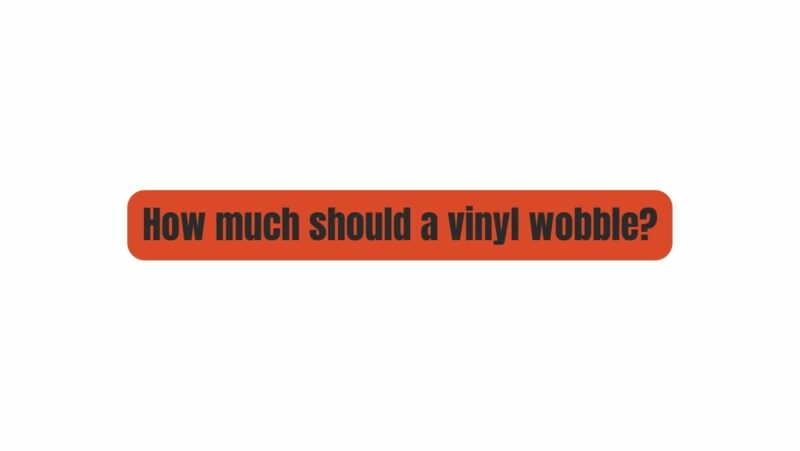Vinyl records have made a remarkable resurgence in recent years, captivating audiophiles and music enthusiasts with their warm, analog sound. Despite the advent of digital music formats, vinyl continues to hold its own as a medium that offers a unique listening experience. However, one aspect that often perplexes both beginners and seasoned collectors alike is vinyl wobble. In this comprehensive article, we will explore the phenomenon of vinyl wobble, its causes, effects, and most importantly, how much should a vinyl wobble for an optimal listening experience.
Understanding Vinyl Wobble
Vinyl wobble, also known as wow and flutter, refers to the subtle variations in pitch and speed that can occur when a vinyl record is played. It can manifest as a slight fluctuation in the pitch of the music, creating a warbling or fluttering effect. Vinyl wobble is generally considered undesirable, as it detracts from the purity and accuracy of the music playback.
Causes of Vinyl Wobble
- Turntable Imperfections: One of the primary causes of vinyl wobble lies in the turntable itself. Even the best turntables are not entirely immune to mechanical imperfections. Variations in motor speed, bearing quality, and platter balance can all contribute to wobble.
- Record Pressing Quality: The quality of the vinyl record itself plays a crucial role. Records with manufacturing defects, uneven thickness, or eccentric grooves are more prone to wobble. High-quality vinyl pressings tend to exhibit less wobble.
- External Factors: Environmental conditions, such as temperature and humidity, can affect vinyl wobble. Extreme changes in temperature or humidity can cause the vinyl to expand or contract, leading to fluctuations in playback speed.
Effects of Vinyl Wobble
Vinyl wobble, when present, can have several adverse effects on the listening experience:
- Auditory Distortion: The most apparent effect is audible distortion in the form of pitch fluctuations and warbling sounds. This distortion can be particularly noticeable during quiet or intricate passages of music.
- Reduced Fidelity: Vinyl wobble can diminish the overall fidelity of the audio playback. It hinders the ability of the turntable to accurately reproduce the original recording.
- Listener Fatigue: Prolonged exposure to wobble-induced distortion can lead to listener fatigue. This is especially true for audiophiles who demand high-quality sound.
Managing Vinyl Wobble
While vinyl wobble is an inherent characteristic of the medium, it can be managed and minimized. Here are some strategies for achieving optimal playback:
- Invest in a High-Quality Turntable: The foundation of any vinyl playback system is the turntable. Investing in a high-quality turntable with precise speed control, stable motor, and a well-balanced platter can significantly reduce wobble.
- Choose Quality Vinyl Pressings: Opt for vinyl records pressed by reputable manufacturers known for their attention to detail and quality control. These records are less likely to exhibit manufacturing defects that contribute to wobble.
- Proper Setup and Calibration: Ensure your turntable is properly set up and calibrated. This includes correct tracking force, anti-skate adjustment, and proper cartridge alignment. Regular maintenance of your turntable is also essential.
- Stabilize Environmental Conditions: Store your vinyl records in a controlled environment with stable temperature and humidity levels. Avoid exposing them to extreme fluctuations.
How Much Should a Vinyl Wobble?
The ideal level of vinyl wobble is a matter of debate among audiophiles. Some argue that any perceptible wobble is unacceptable, while others believe that a slight degree of wobble is inherent to vinyl and can even add to the charm of the medium.
In reality, achieving zero wobble is virtually impossible due to the mechanical nature of turntables and the inherent imperfections in vinyl records. However, a well-maintained and properly calibrated turntable with high-quality vinyl pressings should exhibit minimal wobble, typically below 0.1% of the playback speed. This level is generally considered imperceptible to the average listener.
Ultimately, the acceptable level of wobble depends on your personal preferences and expectations. Audiophiles who demand perfection may invest heavily in equipment and meticulous maintenance to minimize wobble, while others may find a slight amount of wobble acceptable as part of the vinyl experience.
Conclusion
Vinyl wobble, though an inherent characteristic of the medium, is a manageable issue that can be minimized with the right equipment, care, and attention to detail. Understanding its causes and effects is crucial for vinyl enthusiasts seeking the best possible listening experience. While achieving absolute zero wobble is challenging, striving for minimal wobble ensures that the warmth and nostalgia of vinyl can be enjoyed without compromising sound quality.
In the end, the question of “how much should a vinyl wobble?” is a subjective one, and the answer lies in the ear of the beholder. Whether you demand perfection or embrace the quirks of vinyl, the magic of the medium continues to captivate music lovers worldwide.


